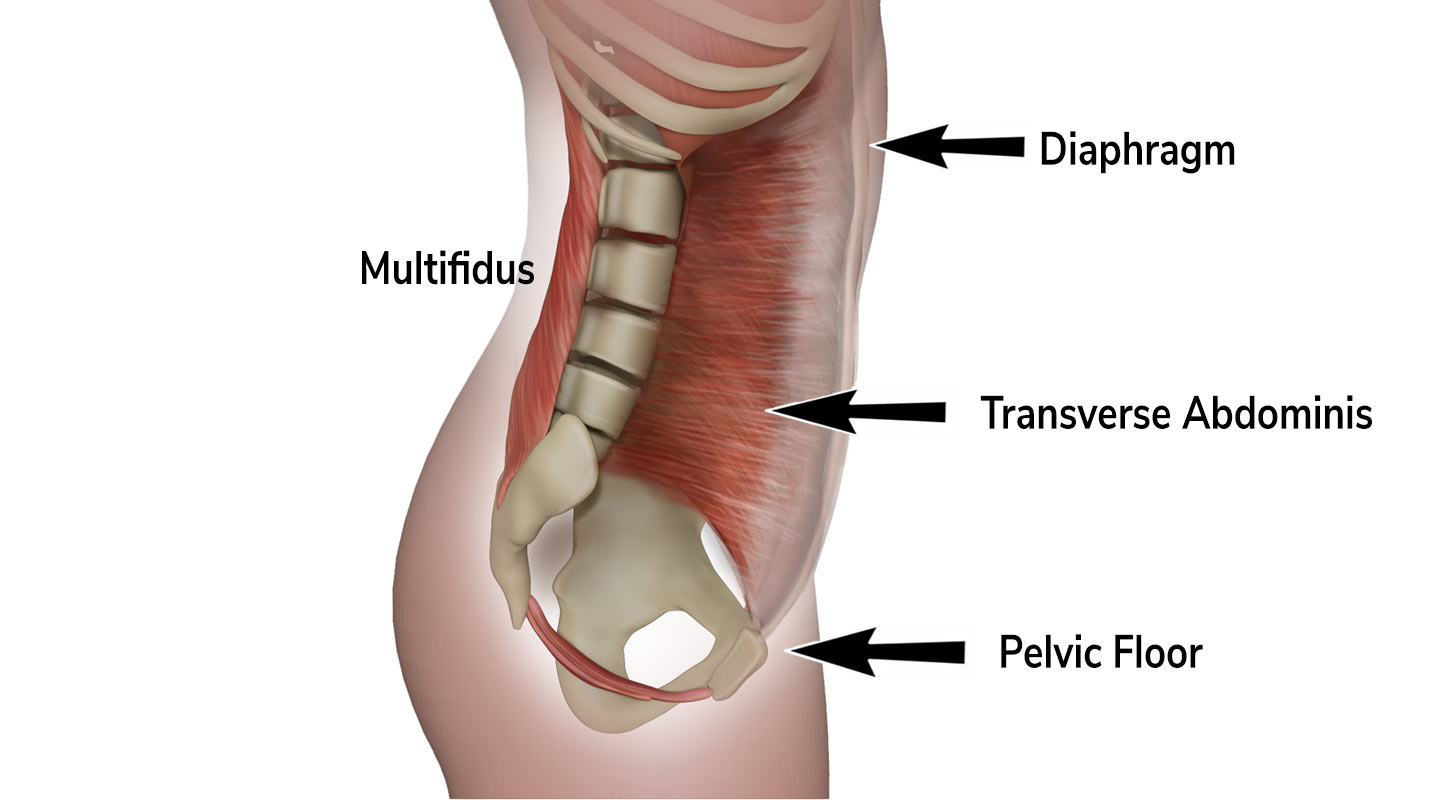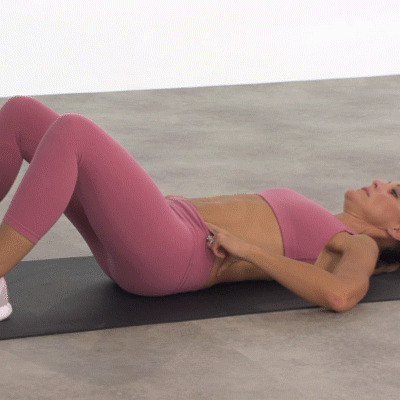
The pelvic floor is a group of muscles that act as a sling to the bottom of your core. As you can see in the image below, the pelvic floor muscles stabilize the joints around the pelvis. The core also includes the diaphragm muscle, the multifidus, and the transverse abdomins.
Pregnancy, childbirth, and decreasing estrogen weaken your pelvic floor muscles. BUT these muscle fibers can be trained! Like any muscle group, you have to specifically target these muscles. You wouldn’t swim to train for a marathon, right? So let’s find the correct muscles to train. The pelvic floor moves are less intense and obvious — you are going to stimulate muscles you won’t necessarily feel all the time. Sometimes it can take several tries to make your brain communicate with your pelvic floor.

A study published in the American Journal of Obstetrics and Gynecology found that moms who’d had a C-section were less likely to do pelvic floor exercises, probably because they didn’t push the baby out with the pelvic floor. But pregnancy itself that affects the pelvic floor, so pelvic floor exercises are a must for every mom. It’s important to note core stability is a key component of pelvic and core health. You can find all of the core stability and pelvic floor exercises in our Core Restore program.
Perform these seated, sitting on a Swiss ball or standing — really you can do these anywhere, but seated on a ball will help you identify the pelvic floor muscles.
Hold ‘Ems
Quick Squeezes
Now that you know how to engage your pelvic floor, it’s important to incorporate this into everyday exercise. Your pelvic floor a key component of what is known as your core — a group of muscles that stabilize your trunk. Your pelvic floor works in close coordination with your transverse abdominis. You really can’t effectively work one without paying attention to the other.
Using the transverse abdominis muscle is a big part of getting your belly healthy again. As you can see in the image above, the TA is a thick layer of muscle. The transverse abdominal muscle wraps around the torso from front to back and the muscle fibers of the TA run horizontally, similar to a corset or a weight belt. These muscles, one on each side, are your true core muscles and strengthening them will give you power and tone your entire body.
In order to fully engage your abdominals, and in particular your transverse abdoinimis (TA), you have to pull your belly button in toward your spine. Pulling your navel toward your spine is not the same thing as sucking in your gut. What do you when you suck in your gut? You hold your breath, you tuck your hips. You don’t want to do that. A great cue is saying “ssssssss” as you exhale. We cue these important exercises in all of our workout programs.

Should I see a physical therapist? My answer is always yes. Especially if you think you’re experiencing any of the conditions below. In just 1 – 2 sessions a women’s health physical therapist can look at your movement patterns to determine if your pelvic floor is turned on too much or not turning on as much as it should. A physical therapist can also help with any pain associated with your pelvic floor.
Relaxin is great for helping the pelvis and rib cage to expand to fit your growing baby. But it will also cause loose joint stability, and can lead to pelvic pain both during and after pregnancy. Relaxin remains in the body while breastfeeding.
Your pelvic floor just carried all the weight of that baby for 10 months, and then you went through delivery. Vaginal deliveries involve the trauma of making room for the baby to come through, and cesarean deliveries involve disruption of the tissues in the front of your abdomen. Both have a significant impact on our pelvic mechanics and ability to perform all our normal activities and jobs in a pain free manner. As mentioned above, relaxin causes laxity in our ligaments. Our pelvis is made up of bones that are tethered together by the ligaments and muscle tendons surrounding the pelvis and sacrum. And there are a bunch them!
It is important to keep working the core with the pelvic tilts, kegels, and foundation moves. Check out our Pelvic Floor Library for more info! Additionally, some women find it feels better to have compression through the pelvis and use a support belt.
It is best to avoid certain moves and exercises. You should avoid the following:
Pelvic pain can be tricky to address on your own as there are so many things that impact pelvic mechanics, pelvic floor health, and trauma that can occur during delivery. If you are having pelvic pain that is not going away with gentle exercise, stretching, or a core restorative program, please follow up with a women’s health physical or physiotherapist. Their job is to assess the cause of your pain and help you get back to life faster and teach you how to take care yourself. You could be sitting or standing with a slight pelvic rotation and this can cause other issues like knee pain. Do not put up with pelvic pain, ladies! It can be so debilitating.
Pelvic dysfunction and subsequently, incontinence, can result from trauma to the nerves in the pelvis, causing the pelvic floor muscles to spasm. More than 30% of women of childbearing age are coping with this aftereffect of pregnancy. These conditions may be exacerbated in wide-stance or prolonged sitting exercises and/or high-impact activity. In addition, episiotomies and natural tears can cause pain when scar tissue attaches to the tissue in the pelvis. A woman can actually reduce the thickness of the scar tissue by massaging it after her incision or tear has healed. It is best that you work one-on-one with a physical therapist.
This condition can be almost debilitating to a pregnant woman and can produce symptoms months after delivery. To ease the symptoms, you should work the pelvic floor muscles. It is best that you work one-on-one with a physical therapist.
In the most serious cases of disruption of or damage to the muscles of the pelvic floor, your muscles could prolapse. Pelvic organ prolapse occurs when the pelvic floor muscles become weak or damaged and can no longer support the pelvic organs. The uterus is the only organ that actually falls into the vagina. When the bladder and bowel slip out of place, they push into the walls of the vagina. While prolapse is not considered a life threatening condition, it may cause a great deal of discomfort and distress. You will want to see your doctor if you suspect you have a prolapse. Pelvic floor physical therapy can be helpful.